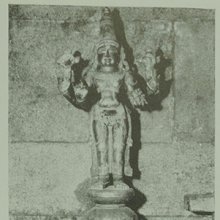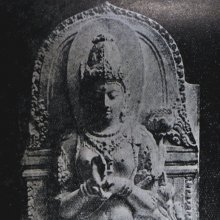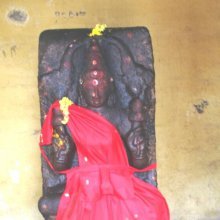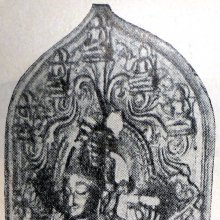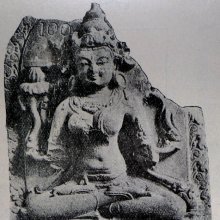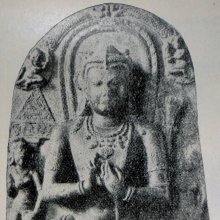Lotus: 6 definitions
Introduction:
Lotus means something in Hinduism, Sanskrit, biology. If you want to know the exact meaning, history, etymology or English translation of this term then check out the descriptions on this page. Add your comment or reference to a book if you want to contribute to this summary article.
Images (photo gallery)
(+335 more images available)
In Hinduism
Natyashastra (theatrics and dramaturgy)
Source: Shodhganga: Elements of Art and Architecture in the Trtiyakhanda of the Visnudharmottarapurana (natya)1) The Lotus complexion (in Indian Dramas) is reserved for Vāsuki, as conveyed through the Aṅgaracanā division of Āhāryābhinaya: one of the four divisions of Abhinaya or “ways to convey or represent one’s emotion to others”, according to the Viṣṇudharmottarapurāṇa, an ancient Sanskrit text which (being encyclopedic in nature) deals with a variety of cultural topics such as arts, architecture, music, grammar and astronomy.—Aṅgaracanā meaning painting of limbs of different characters, also falls under the category of makeover. The Viṣṇudharmottarapurāṇa speaks that it should be done according to the caste, position, superiority and country of respective characters. As for example, this book suggests that Kings and Rich people should have the complexion of lotus; [...] etc. The Nāṭyaśāstra also agrees on it. This is important to note that this type of notes and rules give a social implication of the performance.
2) The Lotus (flower) is also associated with Mukula-hasta: one of the twenty-two Single-hand Gestures (in Indian Dramas) (known as asaṃyuktahastas).—The Viṣṇudharmottarapurāṇa suggests that the tips of all fingers of the hand should be joined together to make this posture. When the tips of all fingers are joined together, it makes a shape of a blooming bud. [...] The posture mukula-hasta is formed to show the activities like worshiping of deities and offering oblations. Moreover, to show the lotus flower this hand posture is suggested to be used in dance performance in the Viṣṇudharmottarapurāṇa.

Natyashastra (नाट्यशास्त्र, nāṭyaśāstra) refers to both the ancient Indian tradition (shastra) of performing arts, (natya—theatrics, drama, dance, music), as well as the name of a Sanskrit work dealing with these subjects. It also teaches the rules for composing Dramatic plays (nataka), construction and performance of Theater, and Poetic works (kavya).
Vastushastra (architecture)
Source: Shodhganga: Elements of Art and Architecture in the Trtiyakhanda of the Visnudharmottarapurana (vastu)1) The Lotus Color is recommended for those Stones that are used as a Material for the Construction of Temples, according to the Viṣṇudharmottarapurāṇa, an ancient Sanskrit text which (being encyclopedic in nature) deals with a variety of cultural topics such as arts, architecture, music, grammar and astronomy.—Finding of proper types of materials is one of the important aspects for any construction. Indian scriptures state that to procure the stones, the astrologer and the architect should go to mountain and examine the stones. In the Viṣṇudharmottarapurāṇa a proper examination of stone is suggested in this regard. In connection with temple building some specific colours of stones are also recommended. These are, for example the colour of lotus.
2) Lotus-shaped Temples (in ancient Indian architecture) are denoted by the Sanskrit term Vaijayantī.—It is quite difficult to say about a definite number of varieties of Hindu temples but in the Viṣṇudharmottarapurāṇa hundred varieties of temples have been enumerated. For example, Lotus-shaped. These temples are classified according to the particular shape, amount of storeys and other common elements, such as the number of pavilions, doors and roofs. [...] The Viṣṇudharmottarapurāṇa relates that the temple named Vaijayantī should be constructed in the shape of a Lotus.

Vastushastra (वास्तुशास्त्र, vāstuśāstra) refers to the ancient Indian science (shastra) of architecture (vastu), dealing with topics such architecture, sculpture, town-building, fort building and various other constructions. Vastu also deals with the philosophy of the architectural relation with the cosmic universe.
Shilpashastra (iconography)
Source: Shodhganga: Elements of Art and Architecture in the Trtiyakhanda of the Visnudharmottarapurana (shilpa)1) The Lotus is denoted by the Sanskrit term Padma, which follows specific guidelines of ancient Indian Painting (citra), according to the Viṣṇudharmottarapurāṇa, an ancient Sanskrit text which (being encyclopedic in nature) deals with a variety of cultural topics such as arts, architecture, music, grammar and astronomy.—In the Viṣṇudharmottarapurāṇa also, different kinds of eyes and their particular shapes are elaborately discussed in the context of Painting. The third variety of the eye should be in the shape of utpalapatra i.e., petals of blue lotus and its measurement should be six yavas. The forth variety of eye should be in the shape of padma-patra i.e., petal of lotus flower and the size should be nine yavas.
2) Lotuses (in water-ponds) are associated with the Autumn Season, which follows specific guidelines of ancient Indian Painting (citra).—The Viṣṇudharmottarapurāṇa gives some instructions to make the picture of every season beautiful and natural. The picture of the autumn season should include the water-ponds along with lots of swans and lotuses. [...] Thus, the Viṣṇudharmottarapurāṇa addresses various elements of nature, such as lotuses in the autumn season, since painting has much connection with time, mood and activity.
3) The Lotus is associated with various deities in iconography.— In the Viṣṇudharmottarapurāṇa, the attire, accessories, weapons, carrier, different colours etc. of the idols of different deities are projected which are taken for discussion here. It is clear that the book offers a great field of knowledge regarding the nuances of Indian art of Image making [e.g., the lotus] during 10th–11th century A.D.
The Lotus of Varuṇa.—The Viṣṇudharmottarapurāṇa accepts four hands in the image of Varuṇa where as the Kāśyapaśilpa and the Śilparatna acknowledge only two. The Viṣṇudharmottarapurāṇa says that the image of Varuṇa holds a lotus and a noose with his right hands as well as a conch and a jewel box with his left hands. The image of Gaurī should be placed on the left side of her husband’s lap. She should hold a lotus in her left hand and her right hand should be placed on the back of her husband.
The Lotus of Indra (Śakra).—Along with the image of Indra, the statue of his wife Sacī is also placed. The idol of Indra should have four hands holding a lotus and an elephant goad in right hands and the vajra in the left hand. Another hand of left side should be placed behind the idol of his wife.
The Lotus of Āditya (Sun-God).—The Viṣṇudharmottarapurāṇa states that the image of Sun god should have four hands whereas, the Bṛhatsaṃhitā accepts two hands here. Sun-beams, reins should be placed in the left and a lotus should be placed in the right hand of the idol of the Sun.

Shilpashastra (शिल्पशास्त्र, śilpaśāstra) represents the ancient Indian science (shastra) of creative arts (shilpa) such as sculpture, iconography and painting. Closely related to Vastushastra (architecture), they often share the same literature.
Yoga (school of philosophy)
Source: ORA: Amanaska (king of all yogas): A Critical Edition and Annotated Translation by Jason BirchThe Lotus is denoted by the Sanskrit term Netra, according to the Yogatārāvalī: a short Yoga text of twenty-nine verses presenting Haṭhayoga as the means to Rājayoga (i.e., Samādhi).—Accordingly, while describing the no-mind state: “We see the Amanaska Mudrā manifesting in [those] most eminent sages because [their] breathing has disappeared, [their] bodies are firm and [their] lotus-eyes (netra-ambuja) are half closed”.

Yoga is originally considered a branch of Hindu philosophy (astika), but both ancient and modern Yoga combine the physical, mental and spiritual. Yoga teaches various physical techniques also known as āsanas (postures), used for various purposes (eg., meditation, contemplation, relaxation).
Mantrashastra (the science of Mantras)
Source: Shodhganga: Kasyapa Samhita—Text on Visha Chikitsa (mantra)The Lotus (in Sanskrit: Padma) refers to one of the five “signs” or “hand-positions” that should accompany the chanting of mantras, according to the Śeṣa-samhitā (p.26, mudrāvidhi).—Mudrā is the position of the hand and finger indicative of various moods and sentiments, and accelerate the effectiveness of the accompanying mantras. The Śeṣasamhitā states that the five Mudrās [e.g., lotus (padma-mudrā)] yield the four puruṣārthas when displayed in the middle and end of a japa. Mantras refers to “that which is chanted by people to obtain their spiritual aspirations”.
Mantrashastra (शिल्पशास्त्र, mantraśāstra) refers to the ancient Indian science of mantras—chants, incantations, spells, magical hymns, etc. Mantra Sastra literature includes many ancient books dealing with the methods reciting mantras, identifying and purifying its defects and the science behind uttering or chanting syllables.
Biology (plants and animals)
Source: Google Books: CRC World Dictionary (Regional names)Lotus in English is the name of a plant defined with Nymphaea lotus in various botanical sources. This page contains potential references in Ayurveda, modern medicine, and other folk traditions or local practices It has the synonym Castalia mystica Salisb. (among others).
Example references for further research on medicinal uses or toxicity (see latin names for full list):
· Trans. Roy. Soc. S. Afr. (1916)
· Cytologia (1980)
· Nymphaea lotus
· Mem. N.Y. Bot. Gard. (1953)
· Beskrivelse af Guineeiske planter (1827)
· Species Plantarum (1753)
If you are looking for specific details regarding Lotus, for example diet and recipes, side effects, chemical composition, health benefits, extract dosage, pregnancy safety, have a look at these references.

This sections includes definitions from the five kingdoms of living things: Animals, Plants, Fungi, Protists and Monera. It will include both the official binomial nomenclature (scientific names usually in Latin) as well as regional spellings and variants.
See also (Relevant definitions)
Starts with: Lotus bark, Lotus feet, Lotus flower, Lotus leaf, Lotus lily, Lotus petal, Lotus seat, Lotus Sutra, Lotus-eye, Lotus-medallion.
Ends with: Blue lotus, Egyptian lotus, Golden lotus, Indian lotus, Kuanyin lotus, Lotus seat, Nymphaea lotus, Sacred lotus, White lotus, Winter lotus.
Full-text (+5848): Padma, Kamala, Aravinda, Pankaja, Nilotpala, Utpala, Pundarika, Kamalini, Mrinala, Nalina, Padmasana, Abjini, Putakini, Jalaja, Saroja, Padmakara, Mrinalini, Padmini, Padmin, Ambhoja.
Relevant text
Search found 366 books and stories containing Lotus; (plurals include: Lotuses). You can also click to the full overview containing English textual excerpts. Below are direct links for the most relevant articles:
Tattvartha Sutra (with commentary) (by Vijay K. Jain)
Verse 3.18 - The dimensions of the other lakes and lotuses < [Chapter 3 - The Lower World and the Middle World]
Verse 3.19 - The nymphs (devī) living in lotuses < [Chapter 3 - The Lower World and the Middle World]
Verse 3.26 - The mountains and the regions in the north of Videha < [Chapter 3 - The Lower World and the Middle World]
Yoga Vasistha [English], Volume 1-4 (by Vihari-Lala Mitra)
Chapter CXVII - Description of the lotus-lake, bee and the swan < [Book VII - Nirvana prakarana part 2 (nirvana prakarana)]
Chapter XLIV - Narrative of gadhi and his destruction < [Book V - Upasama khanda (upashama khanda)]
Chapter III - Description of the royal assembly < [Book V - Upasama khanda (upashama khanda)]
Sahitya-kaumudi by Baladeva Vidyabhushana (by Gaurapada Dāsa)
Text 10.102 < [Chapter 10 - Ornaments of Meaning]
Text 10.56 < [Chapter 10 - Ornaments of Meaning]
Text 10.32 < [Chapter 10 - Ornaments of Meaning]
The Agni Purana (by N. Gangadharan)
Chapter 320 - The different mystic diagrams (maṇḍala)
Chapter 202 - Different flowers used in Worship (puṣpa-adhyāya)
Chapter 30 - Mode of worship of different gods in specially drawn lotus figures
Kavyamimamsa of Rajasekhara (Study) (by Debabrata Barai)
Part 7.4 - Poetic conventions regarding to the Trees, Plants and Creepers < [Chapter 5 - Analyasis and Interpretations of the Kāvyamīmāṃsā]
Part 7.3 - Classifications of Kavisamaya (poetic conventions) < [Chapter 5 - Analyasis and Interpretations of the Kāvyamīmāṃsā]
Part 8.10 - Characteristics of Śarad-kāla (autumn season) < [Chapter 5 - Analyasis and Interpretations of the Kāvyamīmāṃsā]
The Mahavastu (great story) (by J. J. Jones)
Chapter XVI - Earlier history of Padumāvatī (former birth) < [Volume III]
Chapter XXII - Enlightenment of Dīpaṃkara < [Volume I]
Chapter XV - The story of Padumāvatī (Padmāvatī) < [Volume III]
Related products
(+49 more products available)
